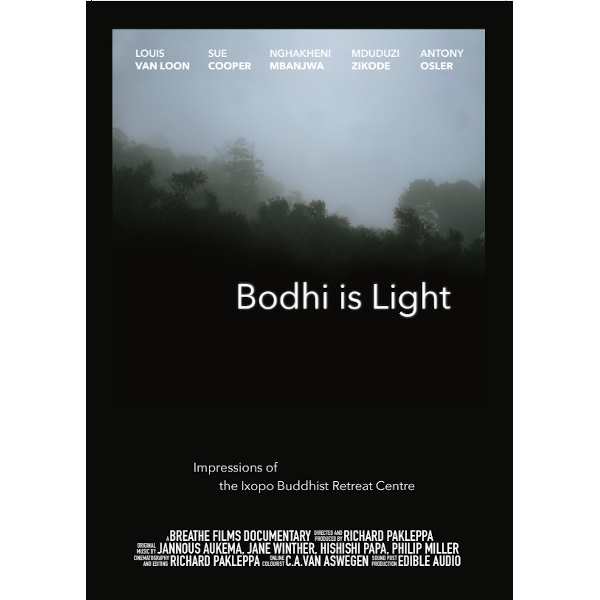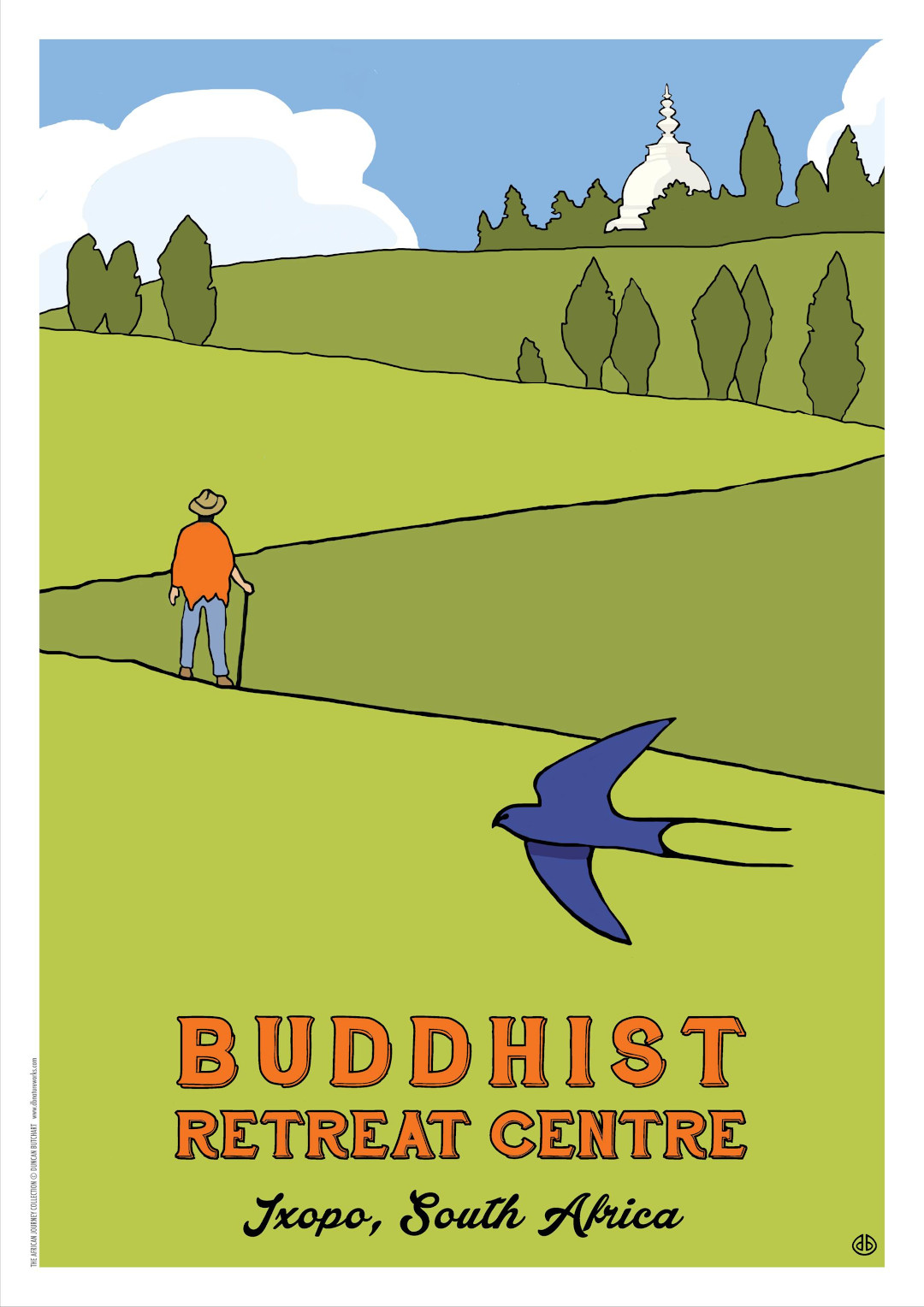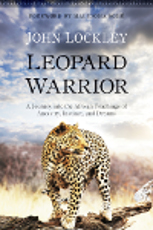If Buddha Was Your Psychotherapist?
 The path and the plane tree | Image: Gavin de Kock
The path and the plane tree | Image: Gavin de Kock
Louis Van Loon once suggested that you could tell a person’s state of mind just by looking at the way they walked. Recalling this leaves me with a clear image of a younger Louis making his way along the well-trodden path between his house and the dining hall, Panama hat covering his purposeful gaze, sure footed without being too rushed, the now giant Plane tree greeting him along the way. The Plane tree still stands cathedral-like, roots crossing the path, branches bowing over passersby - a memorial to those who have come and gone. I think of Junaq and how she might have slowly lost her footing but, stick in hand, the path would have kept her steady, the Plane tree sheltering her from the rising sun on her way back from breakfast. Towards the end of Colin’s stay, we would sometimes find him zig-zagging his way along the same path, frantically looking for his cat, Shadow, insisting that he was definitely missing this time. The “path” is not preordained, it does not precede us, it is made by us. It is made by our coming and going, by the losing and finding of our way. It feels like we are coming to the end of an era of the well-travelled feet along that same path. This leaves me anxious about who I can follow now. How touching, then, it was to encounter Louis’s lifelong friends at his memorial? To hear from Mervin Croft, Antony Osler, Stephen Coan, Ajahn Sucitto and Sue Cooper relate how Louis and his relationship with Buddhism had influenced their lives and practice. There are still feet widening the path.
The first time I ever walked that path, I was following Rob Nairn and the last time I spoke with him was on a zoom call organised by the BRC. He was still sprouting well practised wisdom but in less organised and coherent ways. The gait of his mind was less steady, but the path seemed to keep him true. Rob always had a preference for Tibetan Buddhism, but I chuckled to myself at how he had started to sound somewhat accidentally Zen. As Rob came online you could hear Junaq commenting, unceremoniously, “He is looking really old now”. A funny, unselfconscious, moment that I am sure is easily forgiven between two Dharma friends. This is Buddhism: the fact of our aging; the fact of our suffering; the fact of our inevitable death. As Nagarjuna proposed “You dwell among the causes of death like a butter lamp standing in a strong breeze.” And, so, we must accept the great loss of these well-practiced Buddhists in the breeze of time, an ending of an era, and carry on along the paths they have left for us. The Buddhist “path” is a well-trodden and rigorous philosophical practice, but it is also encouraged that we do not follow it blindly. It is a path of curiosity and wonder, in response to the demands of our time.
 Louis and Rob | Image: Chrisi van Loon
Louis and Rob | Image: Chrisi van Loon
One of the current paths a westernised Buddhism is making its way down is the psychologising of Buddhism as a treatment method for our “mental health”. However, the Zen master Roshi Uchiyama (2004) considers this “bonpu zen” or “utilitarian zen” – a practice that has the utility of improving myself or my conditions. Although he does not necessarily have a problem with such utility of Zen, he cautions that it should not be mistaken for what is more essential to Buddhist practice: non-attachment to the outcomes of practice, especially in relation to how it might benefit “me”. In sharp contrast to applying Buddhist practices to a project of self-improvement, Zen practitioners like David Loy (2018) propose that to practise meditation is to “practise dying” (in sharp contrast to self-preservation). Even though it has become increasingly popular to speak about the dissolving of the ego through meditation or psychedelics, this aim can have an ironic twist: “Look how great I am, I have transcended my ego”. But, other than the irony of this approach, if there is anything we could learn from western psychology it is that willingly getting rid of the ego is a particularly dangerous endeavour. It is, after all, through a sense of “this is me” that we find our bearing along any path. The loss of the functioning of the ego, altogether, can severely disrupt our sense of coherence and cause us to lose our ability to connect in meaningful ways with others. It is not so much the function of the ego that is the problem but that we take this ego for a fixed thing that we attempt to preserve.
It was on a 10-day Vipassana retreat in the 90’s that Rob told the story of how he lost his mind meditating. As far as I can recall, he had been on a several months long retreat at a Thai monastery and the intensive regime of meditation was starting to leave him feeling particularly fragmented. When he approached the teacher, he was told to just keep meditating. Before he knew it, he was running through the Thai forests in fear of horseman, armed with spears, chasing him. It took him some time to recover from this state and, I believe, this is what inspired Rob to dedicate his life’s work to making Buddhism more accessible to Westerners. As a Professor in Criminology, Rob’s background in psychology left him well equipped for the task.
Psychology has become our modern priesthood and words like “denial”, “repression”, “projection”, “narcissism” and “gaslighting” have made their way into our everyday language. If we are to incorporate Buddhism into our western lives, then it is very important that we understand the similarities and differences between Buddhism and Psychology; the ways in which they language our relationship with our existence; and how they might benefit from one another. A chief difference is that conventional psychology views our suffering as the result of a mental illness process. Depression, anxiety, grief and trauma are considered dysfunctions that need to be treated and cured. This immolates the medical model and interprets our “symptoms”, our suffering, as evidence of an imbalance that needs to be corrected. Treatment is aimed at making us supposedly “normal” again. In our western society, “normal” is defined by being positive and productive, regardless of our circumstances.
However, what if depression, anxiety, grief and symptoms of trauma were a form of insight – indications of an awareness of the realities we face. There is no doubt that these experiences may, at times, be deeply uncomfortable and debilitating, and we may need help to get through them. But, are these struggles indications of individual failing and illness? For Buddhism, suffering is the human condition. As Samuel Becket’s (1964) character, Clov, says, “You’re on planet earth, there is no cure for that” (pp. 21-22). This is where the Buddhist path differs from psychology in that it embraces suffering as part of our existence. As a treatment method, Buddhism is not aimed at cure but at care (metta).
 Louis ringing the gong | Image: Angela Shaw
Louis ringing the gong | Image: Angela Shaw
What Buddhism and psychology have in common is that they view denial and repression – the pushing away of things that are hard to face – as central to the causes of mental suffering. Buddhism has a rather simple approach to this, to give “presence”: being with things as they are, no matter what they are. Rather than talk about diagnosable conditions, we can employ Buddhist language and talk about how the mind moves through states (and how some of these states can become deeply habitual and seemingly permanent). Buddhism is a practice for being watchful of these states and not mistaking them for who we are.
R.D. Laing was a practitioner who campaigned against reducing people to their diagnosis and who incorporated zazen into his therapy model. In an interview discussing the concept of madness he explains that despite difficulty with concepts such as schizophrenia, “I am convinced that some people experience extremely unpleasant mental states of bewilderment and/or false lucidity. Essentially, the only way for them to get out of it is to conquer the capacity to look, that is, to simply pay attention to what is happening, without doing anything. Call it Zen, Chan, Satipatthana, it does not matter. If they can somehow manage to let go, without superimposing their own whims, then out of all this chaos a little order seems to begin to emerge.”
If the Buddha was your psychotherapist, it is unlikely that he would encourage you to attempt to murder your ego on a meditation cushion. As Laing cautions, “No matter how hard we try, and despite all the pleasure these efforts may give us, this death is not suicide but rather something to which we must submit. We try in the most subtle ways to evade this submission to a death that perhaps comes from within us but from outside our ego. The ego cannot commit suicide; if we try to commit psychological suicide, we go mad.” Laing goes on to describe how the loss of the ego is not foreign to us. The experience of an ego, an “I”, tends to morph, take on different forms, and even slip away every night as we fall into deep sleep. Even when awake, sitting up straight, in alert focused attention on a cushion, as we explore our own consciousness – there is no ego to be found. What we find is a series of inevitable and mostly habitual reactions to experience. Submitting, wholeheartedly, to the moment is the death of the ego.
 In the meditation hall | Image: Andrew Brown
In the meditation hall | Image: Andrew Brown
Buddha, as your psychotherapist, is likely to invite you to sit with him, saying very little, only to be watchful of this function of consciousness that gives rise to the appearance of “this is me” and a “this is mine”. This egoic process is geared towards grasping at the permanence of things. The Buddha would encourage you to neither push things away nor overly crave after them. To let things be. Together you might pay attentive care to the transitory nature of things, including your own mind states. As you discover that there is no “thing”, like an ego, to be found behind your own consciousness, you might ask “Why the sensation that there is one?” The Buddha might then explain that we all have a feeling of what it means to exist, rooted in our senses. But that, rather than a tangible thing or a “soul”, the ego is born out of the ongoing process of “ahamkara” or “self-making”: the inevitable grasping and aversions to the things we experience in the world. The ego is the position that we take up towards experience and it is full of resistance and strife. Sitting on a cushion, you might come to notice how you are caught up in a constant process of liking and disliking aspects of experience. This gives rise to an inevitable craving for things to be other than what they are. You may gradually notice how your reactions to experiences and the choices you habitually make, shape what you are.
This inevitable response to our own existence has us concluding that “this is me” and we become rigid in this position of an “I am”. As Descartes proclaimed, “I think therefore I am”, but Freud would have asserted that it is your unconscious that thinks, so who knows what you actually are, and yet the Buddha would have empathetically chuckled “you are not what you think”. However, regardless of how the sensation of and “I” comes about, the most dangerous aspect to this “self-making” process is the illusion that “I” am over here, and you are over there, as separate entities. The Buddha encouraged an appreciation of our inherent interrelatedness: “I am because you are”. This highlights an ethical problem with diagnostic thinking: the idea that our struggles are the result of an illness processes in our heads, exacerbating a sense of “us” and “them” - of the mad and the sane. There is no doubt that biological components impact our mind states, but if Buddhism teaches us anything it is that the mind should not be reduced to the brain. If the Buddha was your psychotherapist, he would be weeping with you about the current global genocidal climate. At this moment in human history, deep utter sadness would be an appropriate response to the current state of affairs and not a pathology. The true illness is in global state of things, fuelled by fear and self-interest. The Buddha would have likely discouraged us from going any further along an “us-them” path. From a Buddhist perspective, madness is not necessarily a condition inside my head but in a turning away from reality and especially the inherent causes of our own suffering – egoic grasping. Madness is the loss of our capacity to co-exist in meaningful ways with one another. A Buddhist psychotherapy would encourage us to embrace one another and things as they are. “Let be”, the Buddha would have encouraged, without complacency, but with awareness of your own reactivity.
With Metta,
Dr Jason Ross




 The Retreat Centre is well sign-posted. It can be found off District Road D64 which branches off the R56 between Pietermaritzburg and Ixopo, 5 km from Ixopo. At this turn-off there is a sign saying "Buddhist Retreat". Coming from Pietermaritzburg, just before the D64 turnoff, one passes the Mariathal Mission close to the road, on the left. Please ensure that you arrive before dark - arrivals are encouraged between 3 & 5pm on retreat days.
The Retreat Centre is well sign-posted. It can be found off District Road D64 which branches off the R56 between Pietermaritzburg and Ixopo, 5 km from Ixopo. At this turn-off there is a sign saying "Buddhist Retreat". Coming from Pietermaritzburg, just before the D64 turnoff, one passes the Mariathal Mission close to the road, on the left. Please ensure that you arrive before dark - arrivals are encouraged between 3 & 5pm on retreat days.
 A Journey into the African Teachings of Ancestry, Instinct, and Dreams by John Lockley
A Journey into the African Teachings of Ancestry, Instinct, and Dreams by John Lockley